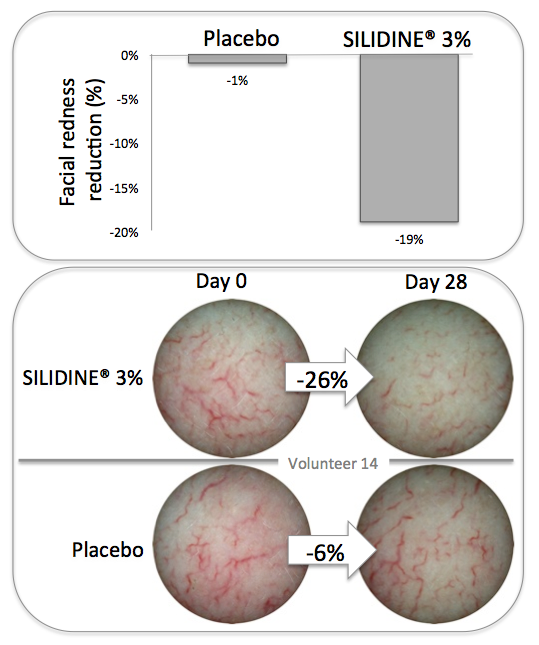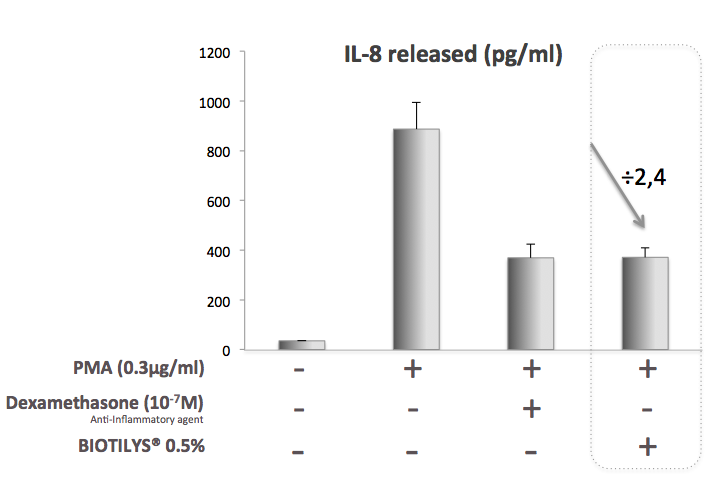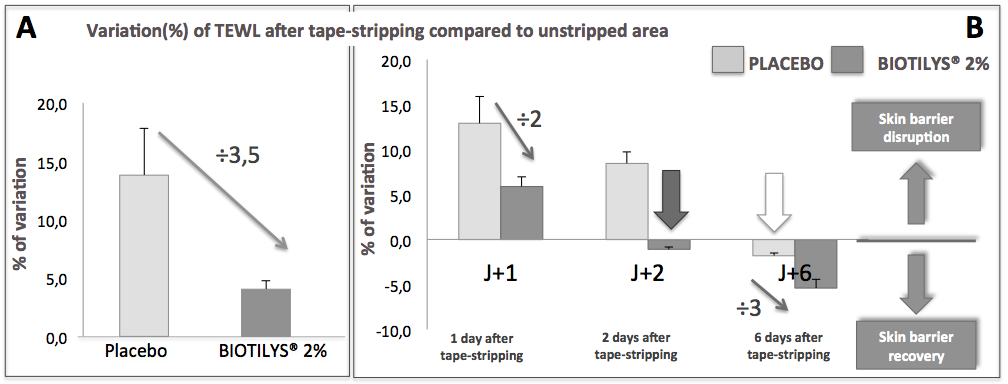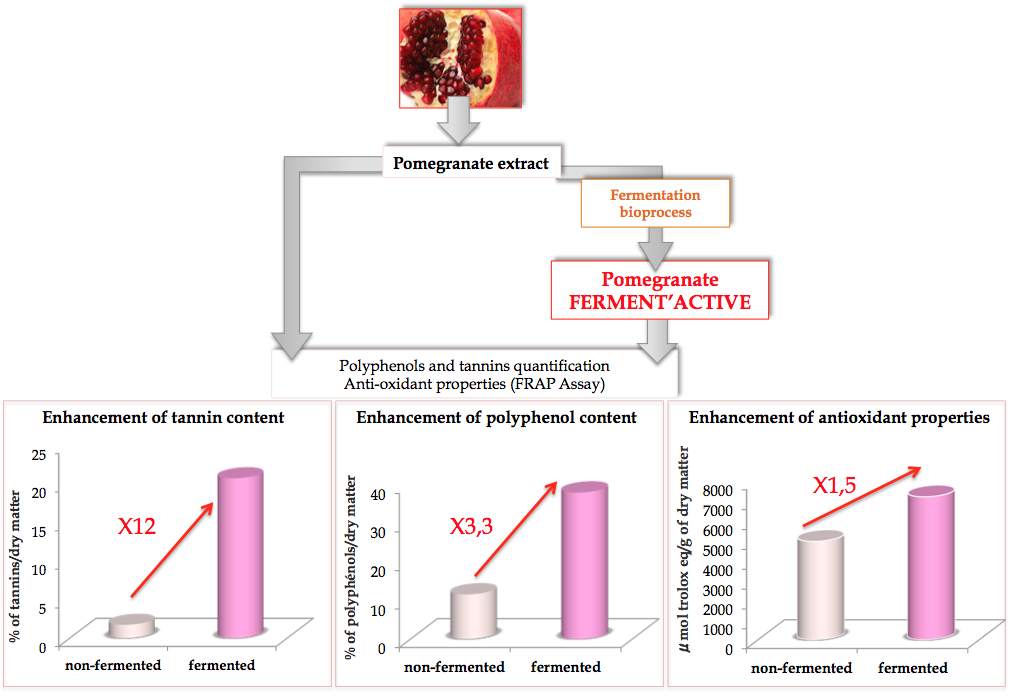| R. Nachat-Kappes, B. Bath, J.-Y. Berthon, Greentech, Rond point du Biopôle Clermont Limagne, 63 360 Saint- Beauzire, France, +33 4 73 33 99 00, greentech@greentech.fr, www.greentech.fr |
KEY WORDS: metabolic induction, fermentation, anti-rosacea, skin barrier, anti-oxidant
ABSTRACT
Cosmetic industry is in permanent search of new, natural and innovative bioactive compounds that present high efficiency and industrial potential. Among the various sources of the next generation of active cosmetic ingredients, marine and microbial natural products provide countless opportunities to identify new molecules that present powerful efficacy.
GREENTECH, specialized in the plant world and green biotechnologies, daily innovates into GREEN and into TECH. To achieve the fair and perfect mix, the company develops efficient actives from (micro)-algae, plants and microorganisms coming from all over the world and using various biotechnologies.
GROWING IMPORTANCE OF MICROALGAE AS SOURCE OF COSMETIC ACTIVES
Microalgae are prokaryotic or eukaryotic photosynthetic microorganisms that can grow rapidly and live in harsh conditions due their unicellular or simple multicellular structure. Classically, the algae are divided into three major groups (green, brown and red) largely based on the colours of the pigments they synthetize. In fact, an extensive range of pigments including phycobiliproteins is present in algae. They are highly fluorescent proteins classified into two large groups, the phycoerythrin (red) and the phycocyanin (blue).
Microalgae have gained a lot of attention as a source of biomolecules and biomass for many purposes, including cosmetic industry. Depending on their environmental conditions such as salinity, light, temperature, pH and nutrient concentrations, described microalgae have been estimated from 40 000 to 60 000 and up to a million of undescribed species (Sastre and Posten 2010). With so many unknown algae species, an almost inexhaustible source of bioactive exists.
Microalgae culture and metabolic induction
The culture of microalgae is easy to modulate because they are able to adapt themselves to multiple constraints. Besides, production of valuable substances by microalgae can be manipulated by the design of cultivation conditions, known as metabolic induction. Especially under suboptimal conditions the algae experience stress and, as a result, produce substances like pigments, carbohydrates or oil. For example, excess of light stimulates the production of carotenes in the cell. At the same time these pigments are antioxidants and protect the cell from harmful free radicals generated by the overdose of light. In fact, all culture parameters can be changed and controlled such as culture medium (nutrient composition), light (intensity, spectral quality, photoperiod), temperature, pH and aeration (gas composition, turbulence).
GREENSEA’s company (belonging to GREENTECH group), which is dedicated to the marine world, is studying (micro)-algae of all kinds and from any origins. GREENSEA has got an important culture collection with more than 100 different species of microalgae. Isolated from multiple waters of the world, they are cultivated in pure strains in photobioreactors that provide a controlled environment for algae culture (Figure 1).

Figure 1: Culture of various microalgae in different type of photobioreactors.
A marine cosmetic active for vascular tonicity
GREENTEH and GREENSEA have developed Silidine® from the red microalga Porphyridium cruentum, using metabolic induction. The microalga is cultivated in optimal conditions and then subjected to oxidative stress. By facing this stress, the microalga changes its metabolism, synthetizes then various molecules as oligosaccharides and highly antioxidant compounds. Transcriptomic analyses showed that Silidine® regulates vascular tone through the up-regulation of the gene encoding for endothelin-1 (ET-1), a potent vasoconstrictor peptide released by the endothelium (Horinouchi, Terada et al. 2013) . Silidine® demonstrated a very good efficacy for vascular tonicity enhancement and inhibition of rosacea. Rosacea is an inflammatory skin condition characterized by marked vasodilation that lead to chronic redness of the nose, cheeks, and sometimes on the chin and forehead (Two, Wu et al. 2015). In fact, small blood vessels in the face dilate and become more visible through the skin.
In vivo study has been conducted on 14 volunteers for 28 days. They applied morning and evening a formulation containing 3% of the active on a hemi-face, and the placebo on the other hemi-face. The anti-rosacea effect was measured via the Siascope and showed that Silidine® significantly decreases by 19% facial redness (Figure 2). Additionally, the efficacy of Silidine® was observed on 86% of volunteers.

Figure 2: Improvement of skin facial redness after 1 month of application of SILIDINE® 3%.
FERMENTATION PROCESS FOR THE DEVELOPMENT OF NATURAL INNOVATIVE COSMETIC ACTIVES
The traditional natural fermentation process has been used for centuries across various cultures. It has a long history of applications in the food but also in pharmaceutical and cosmetic industries. Besides, fermentation is a chemical reaction, which uses microorganisms (bacteria, yeast, moulds) that are capable of growing on a wide range of substrates and can produce a remarkable spectrum of products. In fact, these microorganisms are able to split complex organic compounds into relatively simple substances.
Most probiotic bacteria are similar to the beneficial bacteria that occur naturally in the gut, including those of the Lactobacillus species that can be used in fermentation process. The benefits of probiotic in regulating health have been explored and recognized for over a century. For example, they are largely known to have beneficial effects on intestinal health.
GREENTECH and BIOVITIS, our branch group dedicated to the field of microorganisms, pool their expertise and synergistically combine their research activities in order to develop innovative fermented cosmetic ingredients.
Probiotic fractions: a new approach to skin protection and reparation
GREENTECH developed BIOTILYS®, an active that take advantage of probiotic benefits and that has been generated from an original lactic acid bacteria (LAB): Lactobacillus pentosus, grown with controlled and specific fermentation process (Kobayashi, Saito et al. 2011; Shinkai, Toba et al. 2013) . BIOTILYS® is constituted of specific probiotic fractions including bacterial lysates and cell free culture supernatants. In vitro analysis showed that BIOTILYS® inhibits PMA-induced IL-8 release by 2.4 fold in a reconstructed epidermis, demonstrating anti-inflammatory properties (Figure 3).

Figure 3: BIOTILYS® inhibits PMA-induced IL-8 release/synthesis by a reconstructed epidermis, demonstrating anti-inflammatory properties
Moreover, in vivo study showed that a formulation containing 2 % of BIOTILYS®, immediately after a single application and an external aggression (induced by repeated tape-stripping), was able to preserve and protect the skin barrier function by limiting the trans-epidermal water loss (TEWL) increase (Figure 4A). Furthermore, 2% BIOTILYS® significantly accelerate skin barrier recovery after an external aggression compared to placebo (Figure 4B). Finally, after one week of application, while skin hydration was increased by 8% in placebo-treated area, this increase raised by 36% with 2% BIOTILYS® topical treatment, demonstrating good moisturizing properties. The establishment and the maintenance of the barrier function is the precondition for a healthy skin. Thus, with BIOTILYS®, skin is less vulnerable to external attacks and less subjected to undesired manifestations (redness, dryness, premature wrinkles…). Consequently, thanks to its anti-inflammatory, barrier-strengthening, and moisturizing properties, BIOTILYS® improves the skin texture and appearance under any circumstances.

Figure 4: A) BIOTILYS® inhibits the increase of trans-epidermal water loss (TEWL) induced by tape-stripping, demonstrating barrier-strengthening properties.
B) Skin area treated with BIOTILYS® 2% demonstrates an accelerated skin barrier recovery after tape-stripping. Complete skin barrier recovery is observed 2 days and 6 days after tape-stripping for BIOTILYS® 2% (Dark arrow) and placebo (empty arrow) treated area respectively.
Fermentation bioprocess enhance biological activities of various raw material (plants, algae…)
Fermentation process can be used to enhance biological benefits of plants or other raw material, including (micro)-algae. So far, GREENTECH developed FERMENT’ACTIVES made from specific combination of selected plants and microorganisms. For example, fermentation of a goji extract by Saccharomyces cerevisiae was carried out to increase the amount of polyphenols by 3,3, which are important protective components. Moreover fermentation process significantly enhanced the amount of tannins and polyphenols in a pomegranate extract, by 12 % and 3,3% fold, respectively. Consequently, the fermented extract demonstrates a significant enhancement (by 1,5 fold) of its antioxidant activity and thus, for anti-ageing properties (Figure 5). Finally, a fermented raspberry extract showed an increase by 38 fold of lactic acid amount (an Alpha hydroxy acids, AHA), which is known to act as a gentle exfoliant that improves the facial skin complexion.

Figure 5: Fermentation bioprocess converts components into molecules of interest and enhance biological activities, example of Pomegranate FERMENT’ACTIVE
CONCLUSION
Microalgae and other microorganisms represent an almost inexhaustible source. Their important biodiversity associated with their richness in original compounds make them a unique and natural source of new bioactive molecules. Thus, GREENTECH suggests a large choice of raw material to allow unique and highly efficient actives with specific properties.
REFERENCES
- Horinouchi, T., K. Terada, et al. (2013). "Endothelin receptor signaling: new insight into its regulatory mechanisms." J Pharmacol Sci 123(2): 85-101.
- Kobayashi, N., T. Saito, et al. (2011). "Oral administration of heat-killed Lactobacillus pentosus strain b240 augments protection against influenza virus infection in mice." Int Immunopharmacol 11(2): 199-203.
- Sastre, R. R. and C. Posten (2010). "The variety of microalgae applications as a renewable resource." Chemie ingeniuer technik 82: 1925-1939.
- Shinkai, S., M. Toba, et al. (2013). "Immunoprotective effects of oral intake of heat-killed Lactobacillus pentosus strain b240 in elderly adults: a randomised, double-blind, placebo-controlled trial." Br J Nutr 109(10): 1856-1865.
-
Two, A. M., W. Wu, et al. (2015). "Rosacea: Part I. Introduction, categorization, histology, pathogenesis, and risk factors." J Am Acad Dermatol 72(5): 749-758.



